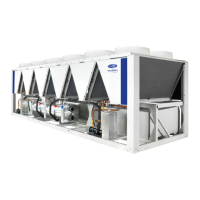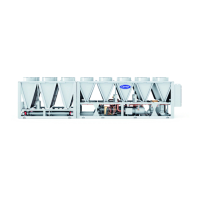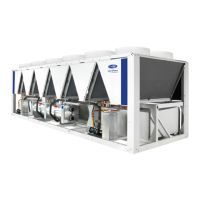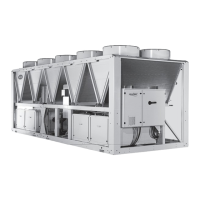5
Carrier Controller Display
The Carrier Controller module is the HMI (Human Machine
Interface) and core of the control system. It contains the major
portion of operating software and controls the operation of the
machine. See “Web and Network Interface” on page 13.
The Carrier Controller module continuously monitors input/
output channel information received from the SIOB (Standard
Input/Output Board) and AUX (Auxiliary) board. The Carrier
Controller module receives inputs from status and feedback
switches, pressure transducers and thermistors. The Carrier
Controller module, through the communications bus, also con-
trols outputs on the SIOB and AUX boards. All inputs and out-
puts that control the chiller are located on other boards. Infor-
mation is transmitted between modules via a 3-wire communi-
cation bus or LEN (Local Equipment Network).
The CCN bus is also supported.
Connections to both LEN and CCN buses are made at terminal
board TB3 located within the control box enclosure to the left
of the Carrier Controller display. See Fig. 1 and 2 for compo-
nent layout showing the display with field connections.
Carrier Controller Display User Interface
The Carrier Controller display is the standard user interface on all
30XV chillers with Greenspeed
®
Intelligence. The display in-
cludes a large 7-in. LCD (Liquid Crystal Display) touch screen for
display and user configuration. A stylus is recommended for use
on the touch screen. The stylus is included with the unit.
WELCOME SCREEN
The Welcome screen is the first screen shown after Carrier
Controller is powered on. See Fig. 3.
The Welcome Screen will automatically change to the Home
Screen when the controller has completed initialization.
HOME SCREEN
The Home screen provides an overview of system controls, al-
lowing the user to monitor the vapor-refrigeration cycle. The
screen indicates the current status of the unit, giving informa-
tion on the unit capacity, refrigerant conditions, occupied sta-
tus, capacity limit, compressor A and B status, the active set
point, and other information. See Fig. 4 and 5.
30XV325
Typical Field Connections Wiring Schematic Fig. 90, pages 227-228
Power Wiring Schematic (Std) Fig. 92, pages 230-231
Power Wiring Schematic (Mid) Fig. 98, page 238-239
Power Wiring Schematic (High) Fig. 98, page 238-239
Communication Wiring Fig. 99, page 240
Control Wiring Schematics Fig. 100-101, pages 241-243
Component Arrangement Fig. 103, pages 246-247
30XV350
Typical Field Connections Wiring Schematic Fig. 90, pages 227-228
Power Wiring Schematic (Std) Fig. 93, page 232-233
Power Wiring Schematic (Mid) Fig. 94, page 234
Power Wiring Schematic (High) Fig. 94, page 234
Communication Wiring Fig. 99, page 240
Control Wiring Schematics Fig. 100, 102, pages 241, 244-245
Component Arrangement Fig. 104, page 248
30XV400
Typical Field Connections Wiring Schematic Fig. 90, pages 227-228
Power Wiring Schematic (Std) Fig. 93, page 232-233
Power Wiring Schematic (Mid) Fig. 94, page 234
Power Wiring Schematic (High) Fig. 94, page 234
Communication Wiring Fig. 99, page 240
Control Wiring Schematics Fig. 100, 102, pages 241, 244-245
Component Arrangement Fig. 104, page 248
30XV450
Typical Field Connections Wiring Schematic Fig. 90, pages 227-228
Power Wiring Schematic (Std) Fig. 93, page 232-233
Power Wiring Schematic (Mid) Fig. 94, page 234
Power Wiring Schematic (High) Fig. 94, page 234
Communication Wiring Fig. 99, page 240
Control Wiring Schematics Fig. 100, 102, pages 241, 244-245
Component Arrangement Fig. 104, page 248
30XV500
Typical Field Connections Wiring Schematic Fig. 90, pages 227-228
Power Wiring Schematic (Std) Fig. 93, page 232-233
Power Wiring Schematic (Mid) Fig. 94, page 234
Communication Wiring Fig. 99, page 240
Control Wiring Schematics Fig. 100, 102, pages 241, 244-245
Component Arrangement Fig. 104, page 248
Table 2 — Control and Power Drawings (cont)
UNIT DESCRIPTION LOCATION
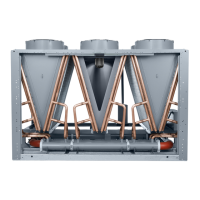
